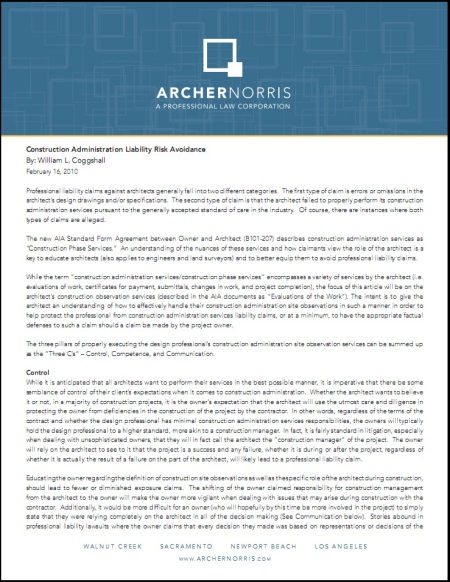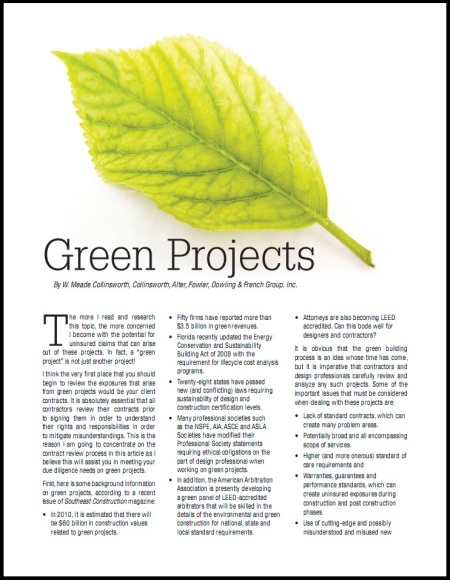 Recently, Bizjournals.com published an article on How to choose an Architect. The author stressed that the hunt for the right architect should include obtaining recommendations from friends and colleagues, calling a potential architect’s references, and studying his or her previous projects to ascertain quality and sustainability.
Recently, Bizjournals.com published an article on How to choose an Architect. The author stressed that the hunt for the right architect should include obtaining recommendations from friends and colleagues, calling a potential architect’s references, and studying his or her previous projects to ascertain quality and sustainability.
This process isn’t news to architects. Every job bid opens an architect’s firm and history to scrutiny, and that’s all part of an owner’s due diligence. What architects and engineers might not consider is that this logical due diligence should extend to them in the selection of their own insurance broker(s).
Remember, “Not every attorney can deal with the problems you are likely to find yourself faced with in professional practice; not every doctor can perform heart surgery; not every insurance broker can deliver the professional liability loss prevention and insurance services you need. Knowing this, it would seem to make sense for you to spend a certain amount of time searching for a broker capable of responding effectively to the unique requirements of your firm.”
a/e ProNet has put together a guide to finding the best specialist insurance broker for your design firm. Authored by David Lakamp, the founder of a/e ProNet, this guide addresses the qualities and qualifications you should require of the broker handling something as important as your Professional Liability policy. The following is an excerpt from our ProNet Practice Note titled How to Select a Professional Liability Insurance Broker:
Your professional liability insurance broker can deliver services of great value. This is as it should be, for you are paying for those services. Carefully selected and advantageously used, your broker can be as important to the management of your practice as your accountant or your attorney. Poorly selected and ill-equipped to advise you on the risks of professional practice, your broker may add little more of value to what you do than the cost of a few postage stamps at renewal time. The choice is yours.
There are many people in the insurance business, but finding the one broker best for you can be somewhat problematic. For one thing, your broker can be of real help to you only if he or she has a comprehensive understanding of what it is you are all about. Not all do. For another, the most valuable services your broker can deliver require an investment of time and resources few are prepared to make. Fortunately, there are knowledgeable brokers throughout the country who have made that investment. Your challenge is to find one you can rely on with confidence.
What a Good Broker Can Do For You
Your broker, first and foremost, is your advocate in the professional liability insurance marketplace. A good broker will know what the markets are doing, who the underwriters are, what they are looking for, and how to present your firm in the best possible light. This requires a thoroughgoing knowledge of the applications for insurance and a clear understanding of what the questions really mean, how the information being requested is likely to be interpreted, and how that information can best be communicated to the underwriters. The cost of your insurance will depend on this knowledge and on the skill and attention to detail with which it is utilized on your behalf.
A skilled professional liability insurance broker will be experienced in dealing with the underwriters in both hard and soft insurance markets. Today’s promises and prices may be real, or they may be of fleeting value. To evaluate the differences, you need competent, independent advice from a broker who is capable of a long look down the road ahead. Experienced brokers have been down this road before, and the value of the advice you receive as you seek to sort out the trade-offs between coverage options, company services, and premium dollars depends on that experience.
Other valuable questions answered by this ProNet Practice Note:
- Why is it important to choose a specialist insurance broker?
- How will I know a specialist insurance broker when I see one?
- Where can I get good recommendations for specialist brokers in my area?
- When I purchase insurance, why shouldn’t price be the bottom line?
- What is the difference between an independent insurance broker and an insurance agent?
- What questions should I ask an insurance broker to make certain he or she fits this criteria and will offer the best, specialized service to my architecture or engineering firm?
We invite you to download the full-length PDF version of this ProNet Practice Note here. For additional resources like this one, visit our website. And as always, the easiest way to find a specialist insurance broker for your firm is to get in touch with your local a/e ProNet Broker.



